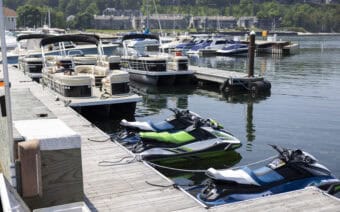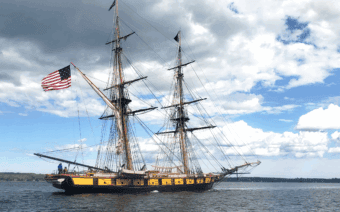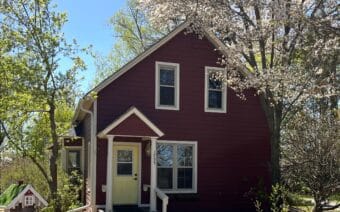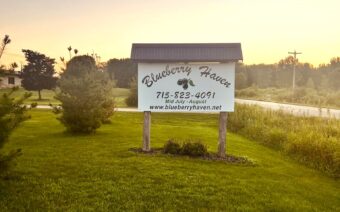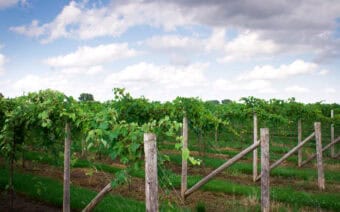
November 29, 2023
ALGOMA – Cities, communities and organizations along the shoreline of the Great Lakes are doing what they can to protect the largest freshwater surface on earth – a slice of which Northeastern Wisconsinites have the privilege of enjoying and experiencing.
Locally, that effort – including a recent push for the implementation of a stormwater mitigation project at Crescent Beach – is being spearheaded by The Friends of Crescent Beach (FOCB).
Cathy Pabich, coordinator at FOCB, said the organization was formed in 2015 as part of the Lakeshore Natural Resource Partnership (LNRP), a nonprofit organization that facilitates programs, projects and partnerships to advocate for natural resource conservation across the Great Lakes.
“Soon after my husband, John, and I retired to Algoma in 2013, we discovered several challenges affecting Crescent Beach and Boardwalk,” Pabich said. “The volunteer beach cleanup group we were once a part of had disbanded. Efforts to secure funding from stormwater management had proved unsuccessful. The city’s beach cleaner was in disrepair, invasive plants had invaded a section of the beach, and there were areas of the beach that were impacted by erosion and a persistent issue with litter.”
After learning more about the issues that were threatening Crescent Beach, as well as water testing resulting in water quality alerts, Pabich said she and her husband knew they needed to collaborate with an organization that would be able to provide the structure and the guidance to address the problems and maintain a healthy beach.
That’s where LNRP came in.
Pabich had attended a presentation by Jim Kettler, director of special projects at LNRP, previously and said she knew LNRP would be the ideal partner.
“A meeting with LNRP and local stakeholders was arranged,” she said. “The response was overwhelmingly positive, with the condition that our collaboration would prioritize actionable steps versus just discussion.”
LNRP provides advice and support to its partners that would otherwise be beyond the capacity of the organization’s community.
Over the years, Pabich said LNRP has helped FOCB “identify and analyze challenges that we faced on the beach,” propose solutions, devise strategies and receive funding for those challenges.
Right now, Pabich said FOCB has been working with LNRP on implementation for a stormwater mitigation project at the beach.
Addressing the issue
Kettler said looking to improve stormwater infrastructure across Lake Michigan isn’t anything new.
“All of these drain directly into Lake Michigan, and the water quality of Lake Michigan has been a concern of both state and federal agencies for a very long time,” Kettler said. “(The stormwater infrastructure) drains directly into Crescent Beach, which impacts the beach as a community asset.”
As Northeast Wisconsin has experienced more severe rain events in recent years, Kettler said it’s easy to see how the aging stormwater infrastructure has impacted the beach.
“If you look at those outfalls during a rain event like that, it’s very clear the damage that’s been done,” he said. “It’s putting dirty water in Lake Michigan without treating it.”

With the help of the Greater Green Bay Foundation, Erin LaBonte and Don Krompos painted Algoma’s first storm drain mural to help bring awareness to stormwater pollution in Crescent Beach and Lake Michigan. Photo Courtesy of John Walch
As Crescent Beach has grown in popularity as a tourist destination, Kettler said the City of Algoma feels a positive economic impact.
And, if the beach suffers due to issues, such as pollution and erosion, he said it can have the opposite effect on the city’s economic impact.
“It’s about (placing) a high priority on water quality, and improving water quality,” he said. “That has been the focus of our programming and projects from (LNRP’s) beginning.”
Pabich said FOCB “feels strongly” that the city has a role in protecting water quality.
“We, as residents of a small community, have a role in making sure we’re not contributing to the problem, but that we’re doing what we can to address it,” she said. “The stormwater outfalls are probably the biggest, most critical factor that we need to address on our beach.”
To Pabich’s sentiment, Kettler said there is a timely policy initiative with the Department of Natural Resources (DNR) and other partners – known as the Northeast Lakeshore (NEL) TMDL (total maximum daily load) – that helps add urgency to dealing with Lake Michigan’s water quality issues.
“(The TMDL) seeks to reduce sediment and phosphorus loads into our surface waters,” Kettler said. “Phosphorus becomes a problem only because it’s being dumped in abundance into our surface waters, and that’s where you get algae blooms.”
The NEL TMDL’s service area, Kettler said, is almost the same as LNRP, meaning “all the river systems, all the tributaries and all of the small frontal watersheds” that drain into Lake Michigan are waters that NEL TMDL and LNRP seeks to protect.
“It’s a policy instrument that forces municipal, county and government hands in terms of taking action to improve water quality,” he said. “There’s funding that goes along with it.”
Pabich said it’s also important that FOCB and LNRP strongly acknowledge that they have to work in cooperation with the local government.
“They’re the decision holders,” she said. “(We also have to) be aware of state and federal regulations.”
Receiving funding, next steps
Kettler said finding funding was another step LNRP and FOCB had to complete to help improve Crescent Beach’s stormwater infrastructure.
Thankfully, he said LNRP has had “a long-standing partnership with the Fund for Lake Michigan.”
“That relationship goes back a decade,” Kettler said. “The Fund for Lake Michigan often provides the design funds so you have a design in place. Then you can go to federal funding sources to get project implementation dollars.”
Kettler said LNRP and FOCB applied for the grant from the Fund for Lake Michigan this past spring and received the award notice in early summer.
Soon after, he said the organizations then put together a design team, hired Stantec – an engineering consultant service – put a work contract together and then worked with the City of Algoma to bring the design elements forward.
The Fund for Lake Michigan also provided grant funding to FOCB to purchase its mechanical beach cleaner, and while it may not seem related to runoff, Pabich said it’s also an important piece to keeping Crescent Beach clean.
“Often included in runoff are things like cigarette butts and other trash, so it also helps with that issue,” she said. “(The machine) is a rake-type cleaner.”
While LNRP and FOCB are working on the designs to improve the stormwater infrastructure, Kettler and Pabich said the City of Algoma has received some funding of its own to create a retention dam for the northern-most stormwater outfall and to redo the marina, which will also help in their project with Crescent Beach.
“The City of Algoma also got very significant federal funding from the Army Corps of Engineers to redo the marina, which has a breakwater that kind of traps the water that makes it a water quality challenge,” he said. “So, that is also complementary to this project, because it’s all connected in terms of the marina, the stormwater outfalls, where the water goes and the quality of the beach.”
Aging stormwater infrastructure isn’t a unique situation for Crescent Beach, Kettler said, as it stretches throughout the Great Lakes.
“If you look at how stormwater used to be done, this is how cities did it,” he said. “(Stormwater was) just dumped right into our waterways.”
Kettler said a lot of the time those improvements can’t be made because municipalities don’t have a grant writer or the capacity to manage federal grants.
Thankfully for LNRP, he said it also received funding from the Brico Fund, which will allow it to put together “what we call a coastal resiliency community impact project” to help address those shortcomings.

Jim Kettler, director of special projects at Lakeshore Natural Resource Partnership, said the designs for the improved stormwater infrastructure are expected to be finished by June 1 of next year. Photo Courtesy of Lakeshore Natural Resource Partnership
“We essentially provide staff on loan to municipalities so that we help them put those grants together, identify priorities, identify projects and then take it from beginning to end,” he said. “It can be a one-year process, it could be a 10-year process, in terms of piecing together that puzzle and finding the right funding sources for different elements.”
Long-term vision
Currently, LNRP and FOCB are still in the design process of the project, which Kettler said is expected to be completed by June 1, 2024.
Once the designs are completed and the project begins to come to life, Pabich said the stormwater outfalls will filter the stormwater before it reaches the recreational areas of Crescent Beach and into Lake Michigan.
The project will also protect access to the beach during high water marks.
“So much of our beach was eroded, and by diverting the stormwater, that also protects the boardwalk that exists on our beach, as well as access to the more natural areas of our beach,” Pabich said.
Polluted waters are not only an issue for the Great Lakes but brings public health reasons as well, which she said she hopes will help grow the community’s support for conservation.
“Our long-term vision, I would say, is that… we’re a community that recognizes environmental, economic, social and health benefits of a healthy beach and waterways,” she said. “When the public sees projects like this happen, when they hear the publicity about it, they are more aware of Lake Michigan, beach and river-related issues. There are things we can do in our own homes that can also work to protect our natural resources, and they can learn more about that as well.”
Part of getting the community to recognize the impact and benefits of keeping a healthy beach, Pabich said, involves educating them about it, something she has done with Algoma High School.
“Students take on projects, they participate in beach cleanups and the invasive species teams,” Kettler said. “Kudos to Cathy and FOCB for initiating some of those partnerships.”
Other communities outside of Algoma have also helped bring more awareness to Northeast Wisconsin water conservation, Pabich said.
Through the Greater Green Bay Foundation, Pabich said Erin LaBonte and Don Krumpos of Yonder – an art studio in Algoma – created a storm drain mural on the corner of Third and Fremont Streets.
“This project… will be expanded on with additional murals and adopt-a-drain community outreach in spring 2024,” Pabich said.
With improved stormwater infrastructure, an educated and involved community and a better-looking beach, Kettler said he hopes the City of Algoma will see the economic impacts that taking care of Crescent Beach brings.
“From our perspective, cleaning up the stormwater drains not only improves the water quality but improves the aesthetic and improves that community asset,” he said. “The economic, social, public health and environmental (problems) are significantly reduced with these upgrades to the stormwater system.”
To keep up with Crescent Beach’s improvements over time, follow LNRP’s and FOCB’s Facebook pages.
 Black & White: An ode to the sustainable black and white Holstein cow
Black & White: An ode to the sustainable black and white Holstein cow Make-A-Wish: ‘Dreams really do come true’
Make-A-Wish: ‘Dreams really do come true’


